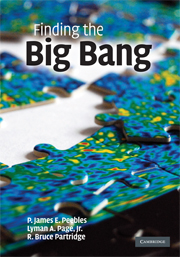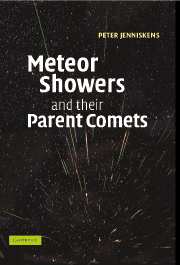Refine listing
Actions for selected content:
17001 results
Appendix A - Fourier transforms
-
- Book:
- Practical Optical Interferometry
- Published online:
- 05 August 2015
- Print publication:
- 28 July 2015, pp 248-254
-
- Chapter
- Export citation
5 - Measurement noise
-
- Book:
- Practical Optical Interferometry
- Published online:
- 05 August 2015
- Print publication:
- 28 July 2015, pp 129-151
-
- Chapter
- Export citation
Contents
-
- Book:
- Practical Optical Interferometry
- Published online:
- 05 August 2015
- Print publication:
- 28 July 2015, pp v-vii
-
- Chapter
- Export citation
9 - Model fitting and image reconstruction
-
- Book:
- Practical Optical Interferometry
- Published online:
- 05 August 2015
- Print publication:
- 28 July 2015, pp 218-247
-
- Chapter
- Export citation
Foreword
-
- Book:
- Practical Optical Interferometry
- Published online:
- 05 August 2015
- Print publication:
- 28 July 2015, pp xii-xiv
-
- Chapter
- Export citation
1 - Making fringes
-
- Book:
- Practical Optical Interferometry
- Published online:
- 05 August 2015
- Print publication:
- 28 July 2015, pp 1-35
-
- Chapter
- Export citation
References
-
- Book:
- Practical Optical Interferometry
- Published online:
- 05 August 2015
- Print publication:
- 28 July 2015, pp 257-264
-
- Chapter
- Export citation
3 - Atmospheric seeing and its amelioration
-
- Book:
- Practical Optical Interferometry
- Published online:
- 05 August 2015
- Print publication:
- 28 July 2015, pp 53-90
-
- Chapter
- Export citation
Frontmatter
-
- Book:
- Practical Optical Interferometry
- Published online:
- 05 August 2015
- Print publication:
- 28 July 2015, pp i-iv
-
- Chapter
- Export citation
6 - Interferometric observation of faint objects
-
- Book:
- Practical Optical Interferometry
- Published online:
- 05 August 2015
- Print publication:
- 28 July 2015, pp 152-179
-
- Chapter
- Export citation
8 - Data reduction
-
- Book:
- Practical Optical Interferometry
- Published online:
- 05 August 2015
- Print publication:
- 28 July 2015, pp 194-217
-
- Chapter
- Export citation
Preface
-
- Book:
- Practical Optical Interferometry
- Published online:
- 05 August 2015
- Print publication:
- 28 July 2015, pp xv-xviii
-
- Chapter
- Export citation
7 - Observation planning
-
- Book:
- Practical Optical Interferometry
- Published online:
- 05 August 2015
- Print publication:
- 28 July 2015, pp 180-193
-
- Chapter
- Export citation
Principal symbols, functions and operators
-
- Book:
- Practical Optical Interferometry
- Published online:
- 05 August 2015
- Print publication:
- 28 July 2015, pp viii-ix
-
- Chapter
- Export citation
Appendix B - Supplementary online material
-
- Book:
- Practical Optical Interferometry
- Published online:
- 05 August 2015
- Print publication:
- 28 July 2015, pp 255-256
-
- Chapter
- Export citation
List of abbreviations
-
- Book:
- Practical Optical Interferometry
- Published online:
- 05 August 2015
- Print publication:
- 28 July 2015, pp x-xi
-
- Chapter
- Export citation
4 - Interferometers in practice
-
- Book:
- Practical Optical Interferometry
- Published online:
- 05 August 2015
- Print publication:
- 28 July 2015, pp 91-128
-
- Chapter
- Export citation

The Drake Equation
- Estimating the Prevalence of Extraterrestrial Life through the Ages
-
- Published online:
- 05 July 2015
- Print publication:
- 02 July 2015

Finding the Big Bang
-
- Published online:
- 05 July 2015
- Print publication:
- 26 March 2009

Meteor Showers and their Parent Comets
-
- Published online:
- 05 July 2015
- Print publication:
- 14 September 2006
